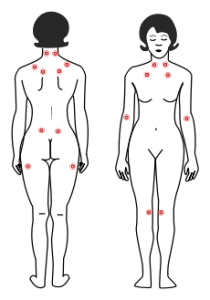Visit and Join the WeHeal Fibromyalgia Community.
For more information, see: Mayo Clinic | Wikipedia | CDC

Visit and Join the WeHeal Fibromyalgia Community.
For more information, see: Mayo Clinic | Wikipedia | CDC

Fibromyalgia is a disorder of unknown etiology characterized by widespread pain, abnormal pain processing, sleep disturbance, fatigue and often psychological distress. People with fibromyalgia may also have other symptoms; such as, Morning stiffness, Tingling or numbness in hands and feet, Headaches, including migraines, Irritable bowel syndrome, Sleep disturbances, Cognitive problems with thinking and memory (sometimes called “fibro fog”), Problems with thinking and memory (sometimes called “fibro fog”), Painful menstrual periods and other pain syndromes Prevalence
The prevalence of fibromyalgia is about 2%, affecting an estimated 5.0 million adults in 2005. Prevalence was much higher among women than men (3.4% versus 0.5%)
Most people with fibromyalgia are women (Female: Male ratio 7:1). However, men and children also can have the disorder.
Most people are diagnosed during middle age and prevalence increases with age.
Working age women with fibromyalgia hospitalized for occupational musculoskeletal disorders were almost 10 times less likely to return to work and 4 times less like to retain work at 1-year post hospitalization.
Working adults with fibromyalgia average almost 17 days of missed work per year compared to 6 days for persons without fibromyalgia. Fibromyalgia has been associated with lower levels of health-related quality-of-life and more work productively loss.
Visit and Join the WeHeal Fibromyalgia Community.
For more information, see: Mayo Clinic | Wikipedia | CDC
WeHeal is very grateful to our valued sources of information which include Wikipedia, WebMD, ClinicalTrials.gov, Cancer.gov, Infoplease, and the US CDC (Center for Disease Control).